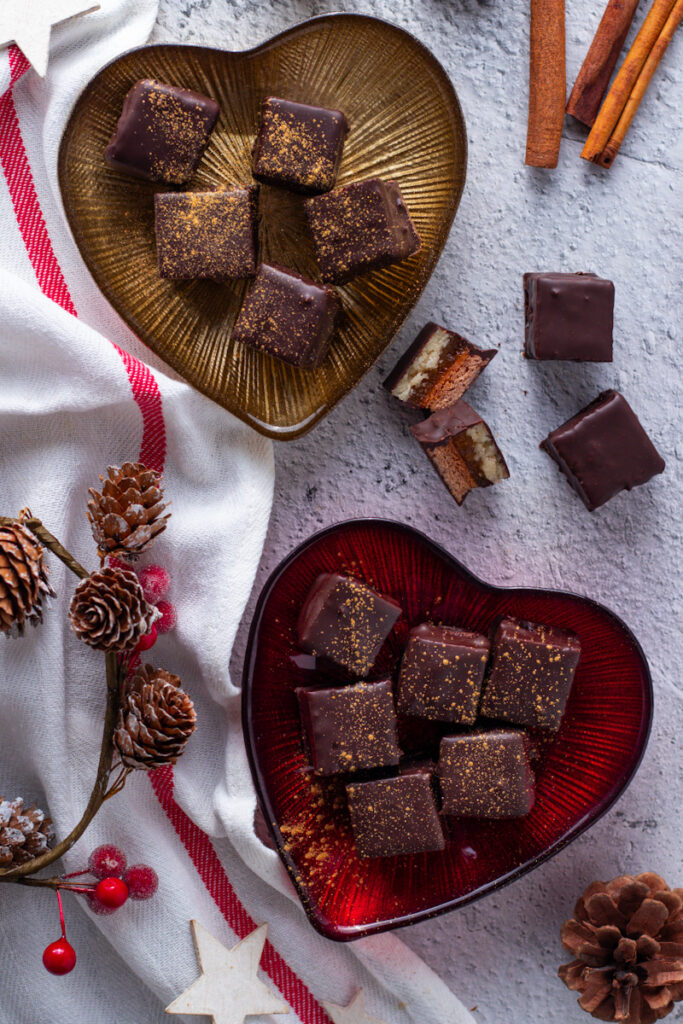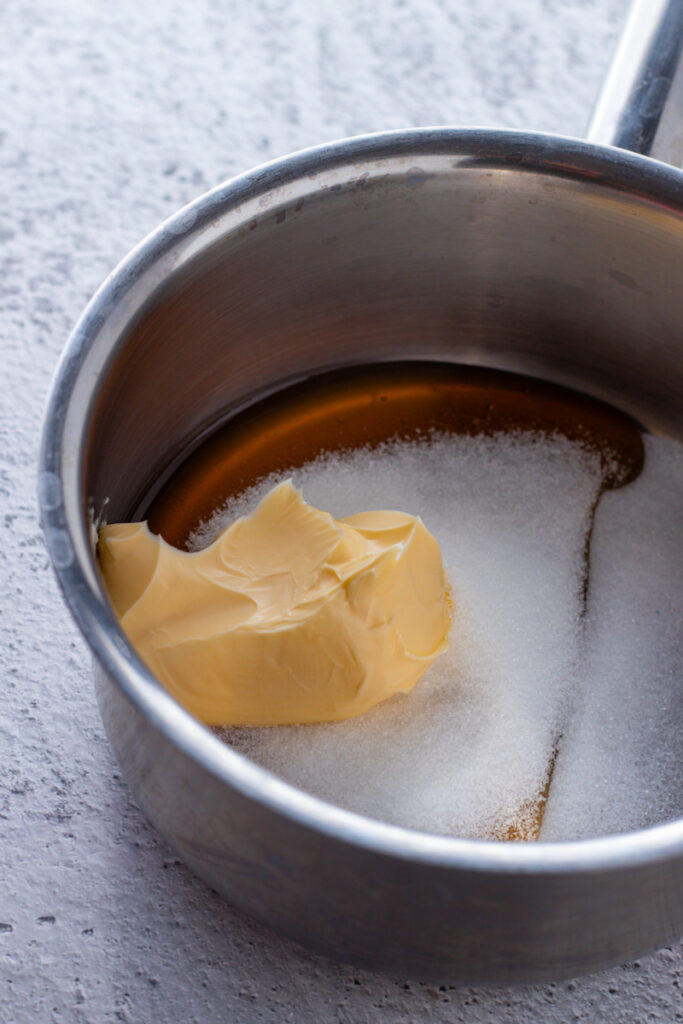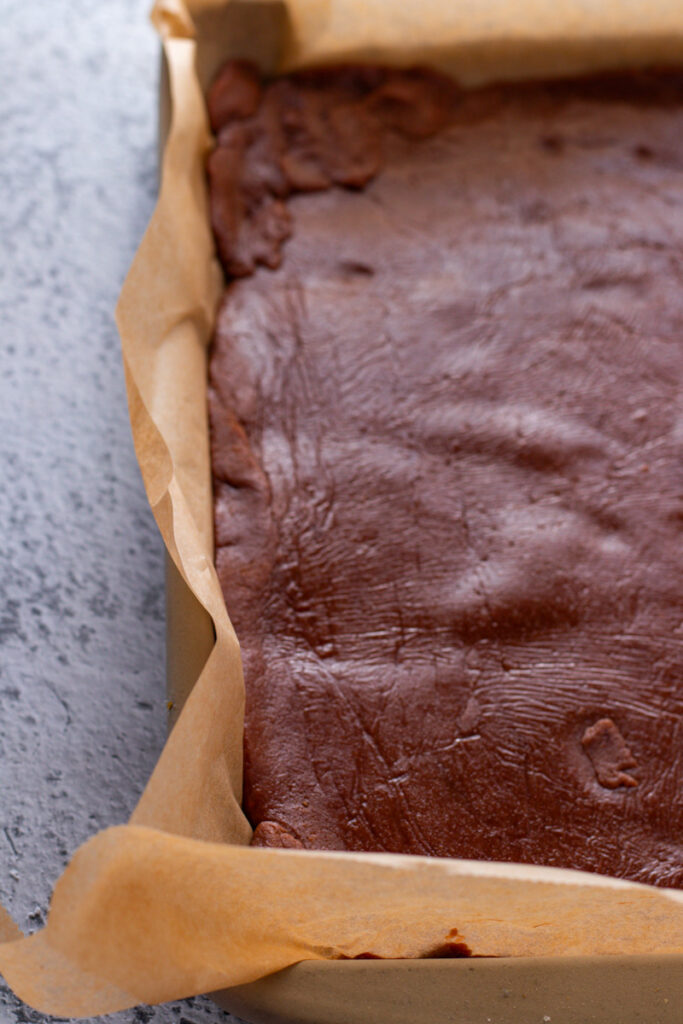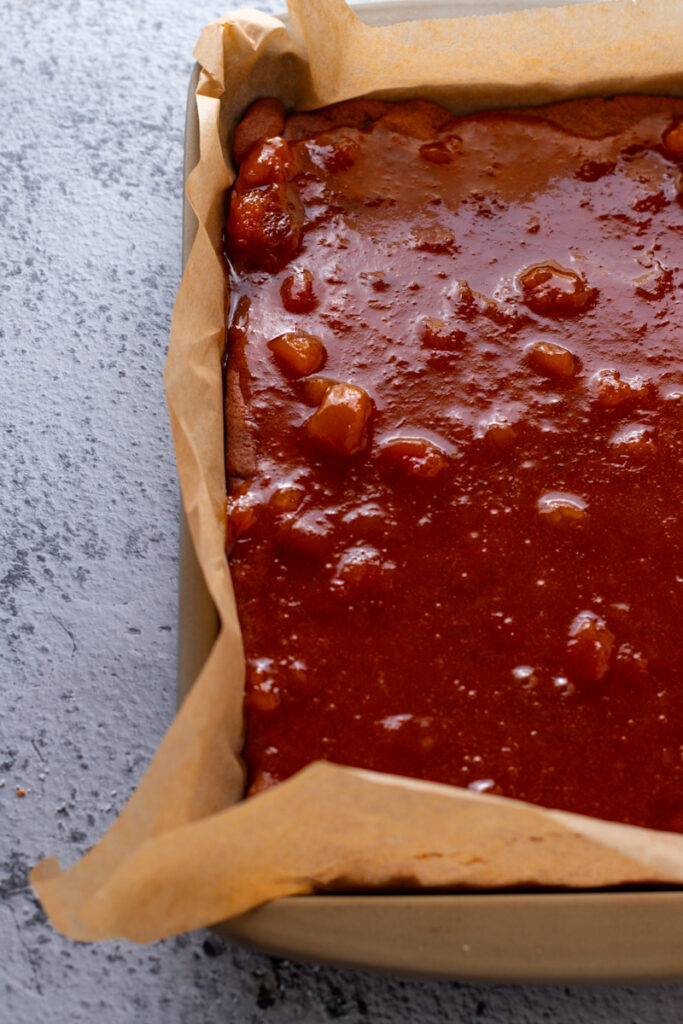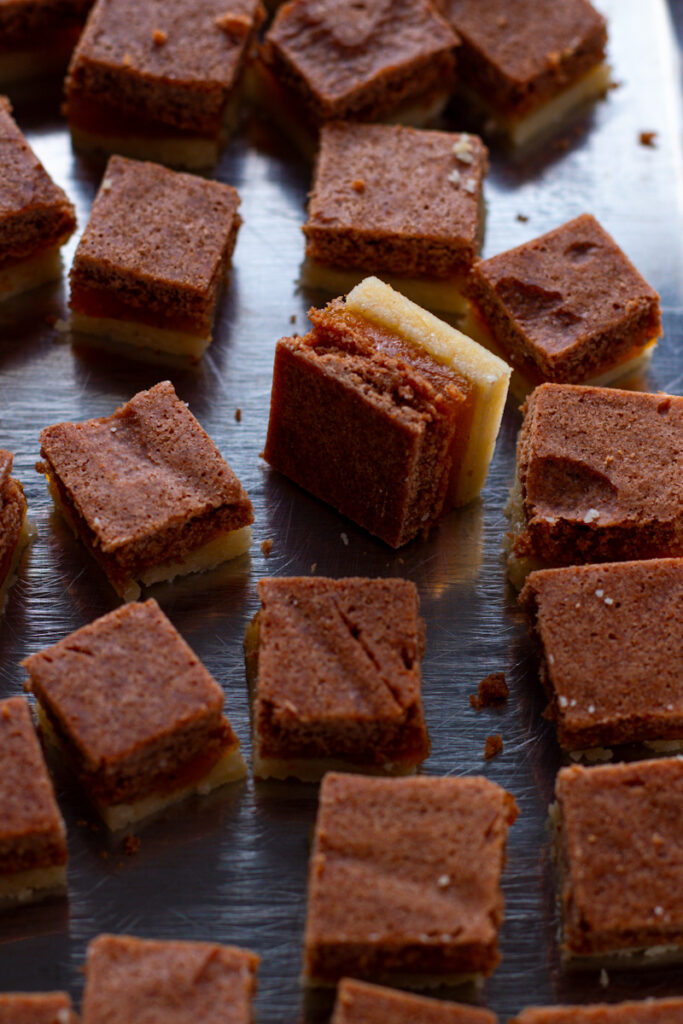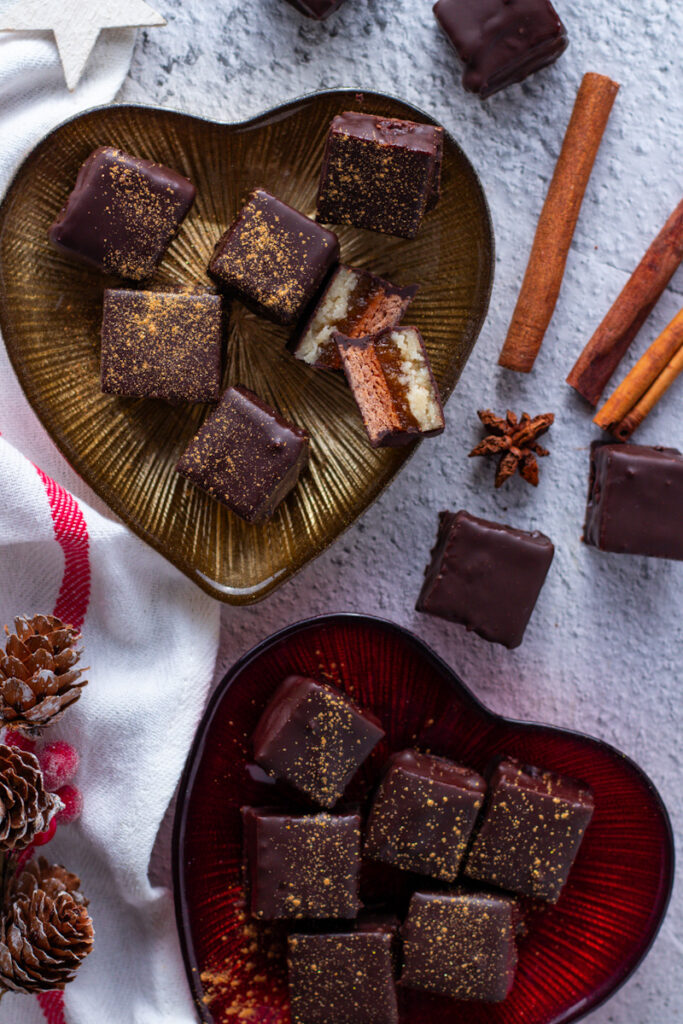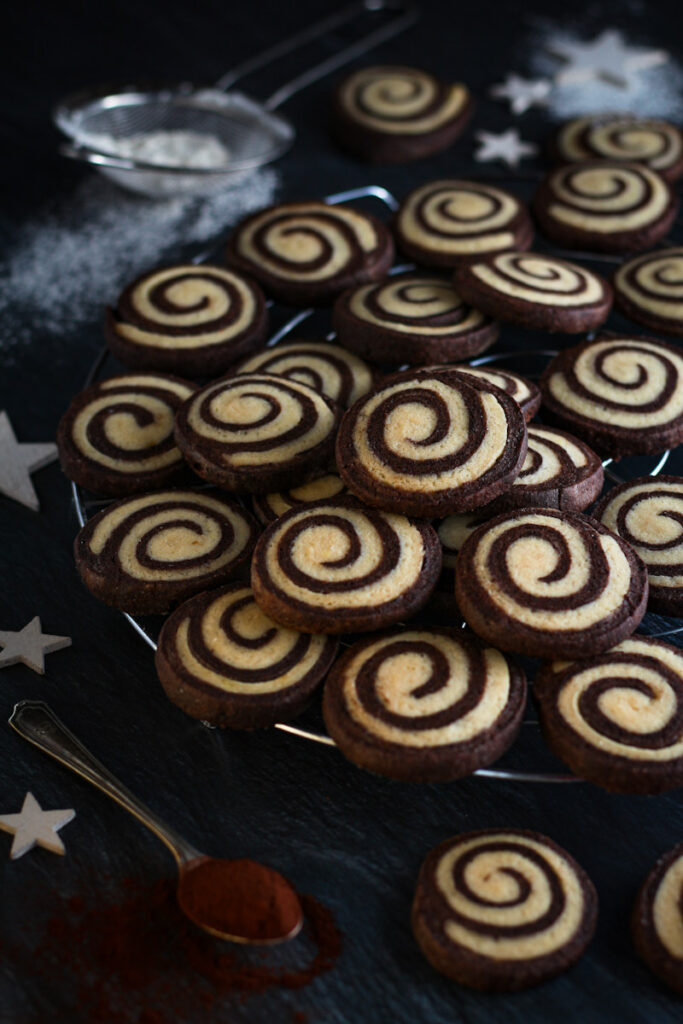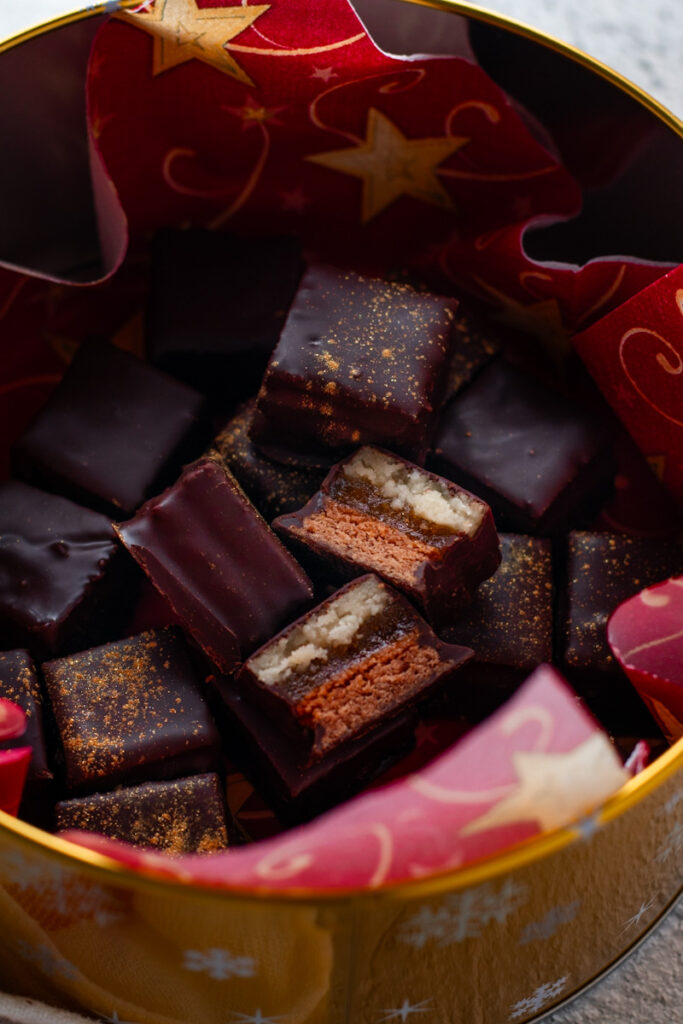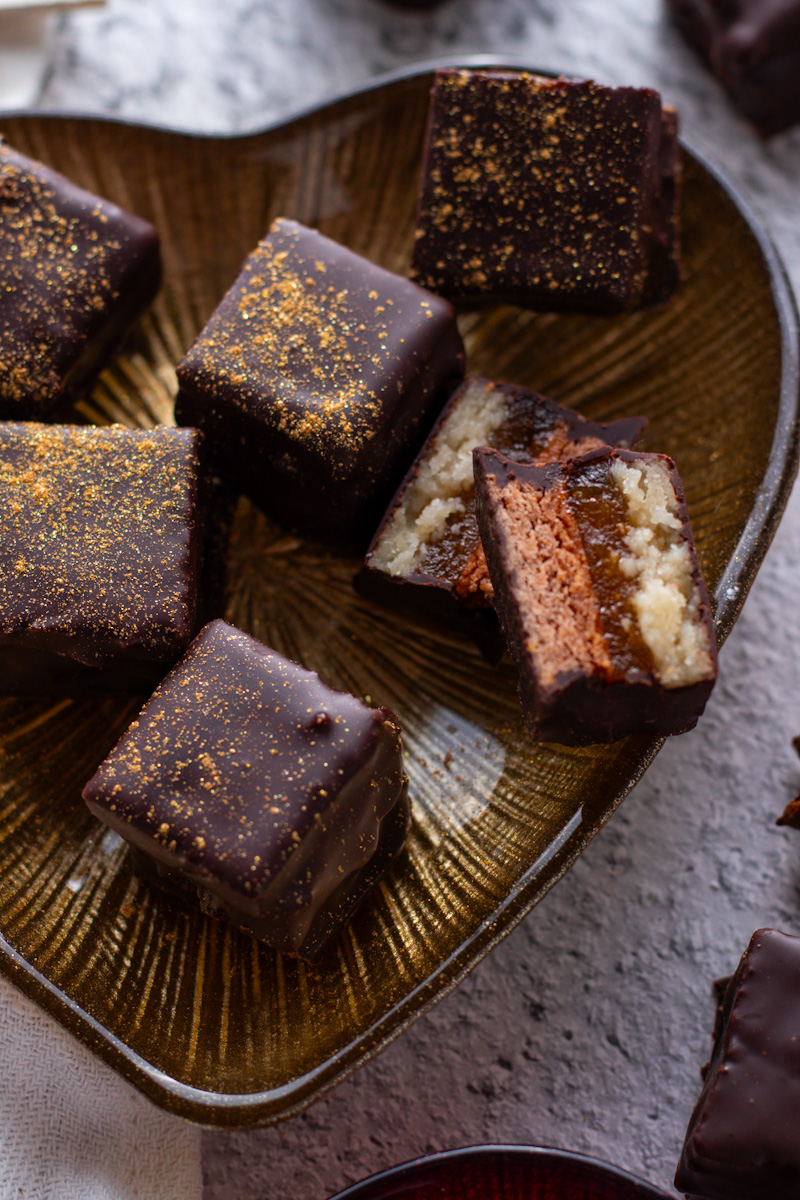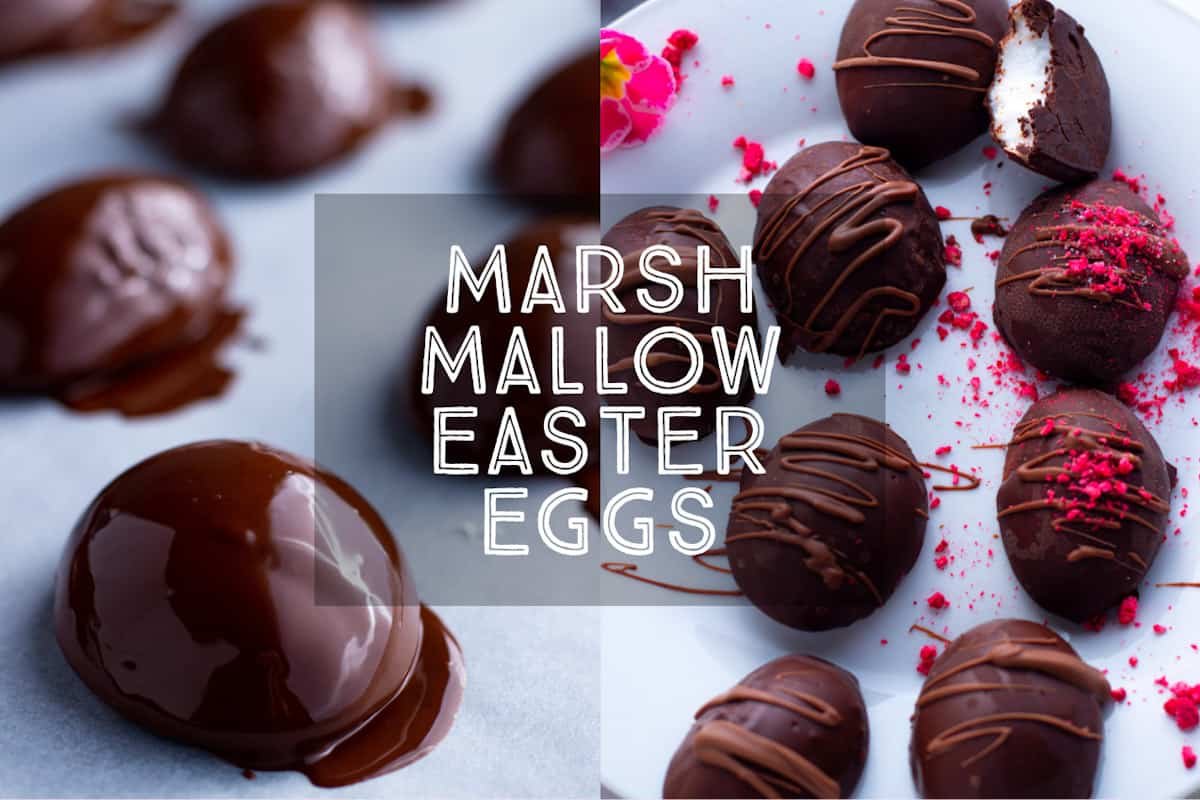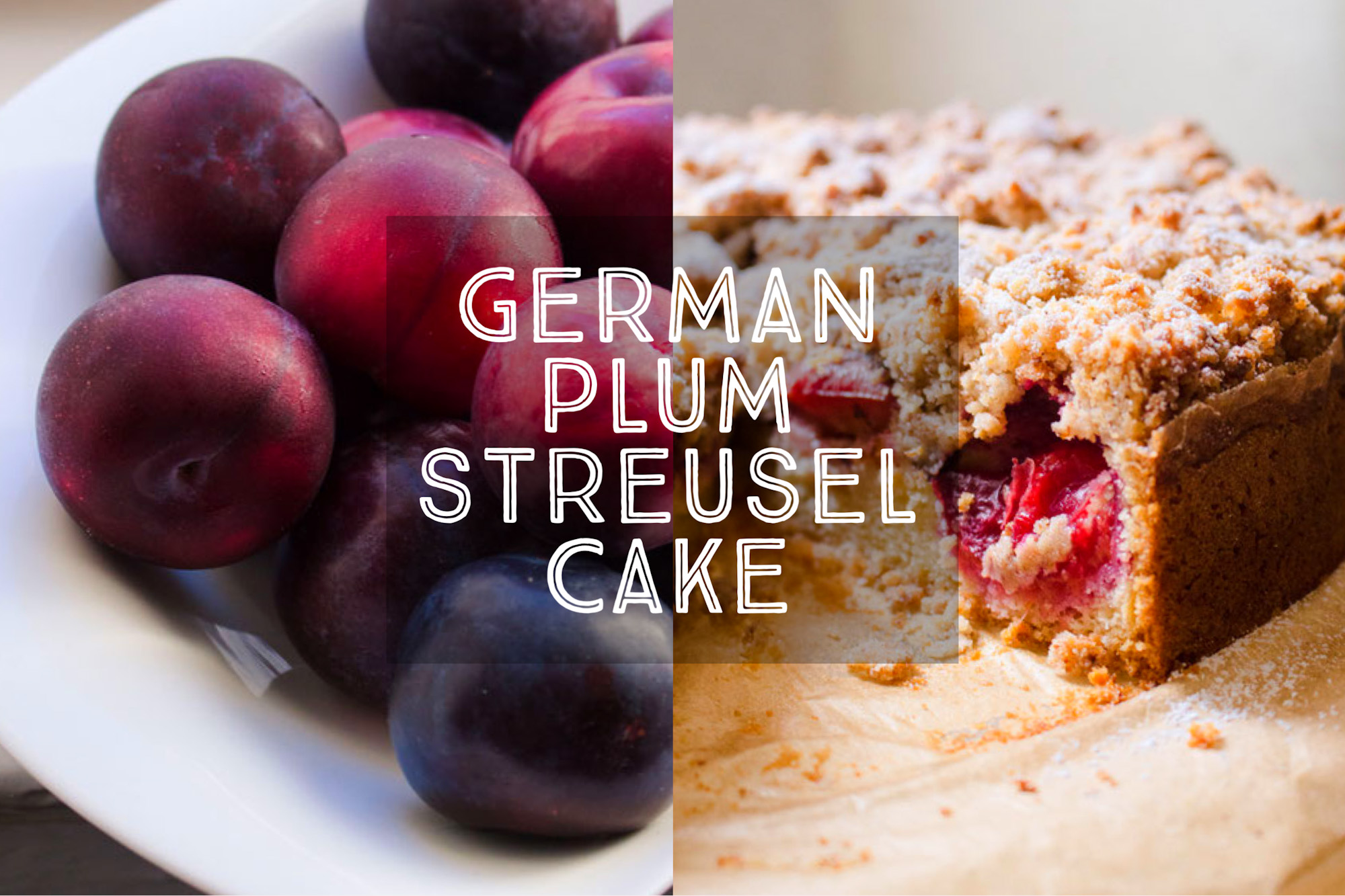

German Dominosteine Chocolates
Dominosteine are a traditional German Christmas praline made from layered gingerbread, fruit jelly and marzipan, all coated in a luscious layer of rich dark chocolate. These delicious treats are fun to make at home and are so tasty!
The scent of roasted chestnuts is in the air, and the shops are filling up with tinsel and ornaments. It can only mean the Christmas season is on the way. Here in Germany, one of the tastiest Christmas treats is Dominosteine chocolates.
While they are not so well known outside Germany, these delicious sweets are made from gingerbread, fruit jelly and a layer of marzipan coated in rich, dark chocolate. They are perfect for chocolate lovers and so good that one is never enough!
TABLE OF CONTENTS
▼
About Dominosteine
Dominosteine (domino stones) were invented in Dresden in 1936 by the chocolatier Herbert Wendler. Made from simple ingredients, these were a more affordable option than the other luxury pralines he sold in his shop.
Fast forward nearly 100 years, and you’ll find Dominosteine in every household come Christmas time, and for a good reason – they are delicious!
Ingredients
To make Traditional German Dominosteine, you’ll need the following main ingredients:
- Honey: Gingerbread of Lebkuchen is traditionally sweetened with honey. I use a squeezy jar of runny honey to make baking easier.
- Sugar: I use plain white sugar in this recipe, though you could swap it out for brown sugar if you wanted a more pronounced caramel flavour.
- Butter: I always use unsalted butter in baking recipes to control the amount of salt in the final product.
- Flour: In Germany, we use soft cake flour for baking (405 flour), though in this recipe, you can use plain, all-purpose or Tipo 00 flour.
- Unsweetened Cocoa Powder: This gives the gingerbread a lovely colour and a hint of bitterness. Try to get Dutch Processed cocoa powder if you can; it tastes and looks better in baking.
- Mixed Spice: We use Lebkuchengewurz, a gingerbread spice mix in Germany. In the US, you can use Gingerbread or pumpkin spice; in the UK, Australia and New Zealand, you can use mixed spice.
- Jam / Jelly: You’ll need a jar of fruit jam or jelly for the fruit layer. I like to use apricot or plum as they have a natural tartness that offsets the sweetness of the rest of the recipe.
- Gelatine: To stabilise the fruit layer. Gold-strength sheet gelatine is the simplest and most reliable to work with.
- Marzipan: Marzipan forms the top layer of Dominosteine. I like to make my own marzipan (recipe coming soon) as it is easy and tastes way better than store-bought.
- Chocolate: Dominosteine are coated in dark chocolate couverture. I’ve given a method for simple tempering of chocolate in the recipe, but if you’re new to working with chocolate, I’d suggest investing in some coating chocolate (link in the recipe card). It makes dipping pralines, truffles or fruit super easy.
The complete ingredient list and detailed instructions are in the recipe card at the bottom of the page.
Instructions
Dominosteine are simple to make, but as you work in layers, there are a few steps.
- First, make the gingerbread by melting the butter with honey and sugar. Mix the dry ingredients, add the warm honey mixture and egg yolk, then knead briefly to a soft dough. Line an approximately 20x30cm (8x12in) tray with baking parchment paper, roll the gingerbread to fit, then bake for 15 minutes at 180°C / 350°F / Gas 4.
- While the gingerbread is baking, soften the gelatine sheets in cold water and heat the jam to make it pourable. Stir through the squeezed out gelatine and set aside.
- When the gingerbread and the jelly have cooled a little, pour the jelly over the gingerbread and transfer to the fridge to set. Roll out the marzipan to fit and place on top when the jelly is set and tacky to the touch. Press down gently, then chill for one hour.
- Invert the large Dominostein onto a cutting board, and cut into squares approximately 2cm (just under 1 in.) with a sharp knife. Melt the chocolate in a double boiler, then use a toothpick to dip each Dominostein in the chocolate. Shake off any excess, then place on a tray lined with baking paper or a silicone mat to set.
Frequently Asked Questions
What do I do if the chocolate doesn’t set or is too soft?
Tempering chocolate is a real science and can be a little finicky. If your chocolates aren’t setting, transfer to the refrigerator. You’ll need to store them in the refrigerator, but they will still be perfectly delicious. See the tips about using coating chocolate.
How do I store Dominosteine?
In Germany, all Christmas cookies are stored in cookie tins. You can either use a metal tin or an airtight container.
Can I make Dominosteine without nuts? I have a nut allergy.
You can make a nut-free marzipan using semolina. I’ve yet to experiment with it, but plenty of recipes are online.
Looking for more German Christmas Cookie Recipes? Check out some of my favourites here!
Dominosteine Recipe
German Dominosteine Chocolates
Dominosteine are a traditional German Christmas praline made from layered gingerbread, fruit jelly and marzipan, all coated in a luscious layer of rich dark chocolate. Invented in Dresden in 1936 by chocolatier Herbert Wendler, these delicious treats are fun to make at home and are so tasty!
Ingredients
for the gingerbread:
- 100 g runny honey
- 50 g white sugar
- 50 g unsalted butter
- 200 g plain or all-purpose flour
- 1 Tbsp unsweetened cocoa powder
- 2 tsp mixed spice, Gingerbread spice or Pumpkin Spice mix
- ½ tsp baking powder
- pinch of salt
- 1 egg yolk
for the fruit layer:
- 4 sheets of gelatine
- 350 g apricot, raspberry or plum jam
- 1 Tbsp lemon juice
for the marzipan:
- 350 g marzipan (make your own!)
- a little powdered sugar
for the chocolate coating:
- 500 g dark chocolate, good quality couverture or coating chocolate if possible
Instructions
- MAKE THE GINGERBREAD: Heat the oven to 180°C / 350°F / Gas 4. Melt butter, sugar and honey in a small saucepan, stirring until the sugar dissolves. Remove from heat. Mix the flour, cocoa, spices, baking powder and salt until well combined in the bowl of a stand mixer with the dough hook fitted. Add the honey mixture and egg yolk to the flour mixture, then knead just until the dough is smooth.
- BAKE: Line a 20x30cm baking dish with parchment paper, roll out the gingerbread dough to the same size (it helps to use two pieces of clingfilm) and lift it into the dish. Bake for 15 minutes, then remove from the oven and allow to cool.
- MAKE THE JELLY: Soak the gelatine sheets in a bowl of cold water while the gingerbread is baking. Heat the jam and lemon juice in a small saucepan until nearly boiling. Remove from the heat, squeeze out the gelatine sheets and add to the saucepan one by one, stirring until dissolved. Allow to cool for 10 minutes, then pour over the gingerbread. Transfer to the refrigerator.
- ROLL OUT MARZIPAN: Dust the bench top with powdered sugar, then roll out the marzipan to a rectangle 20x30cm (8×10 in.) Lift the marzipan gently onto the jelly layer, press down gently to attach, then chill for 1 hour.
- SLICE: When the layers have chilled, place a cutting board on top of the dish, invert and remove the baking paper. Cut into 2cm squares (just under 1 in.)
- MELT CHOCOLATE: Cut the chocolate into small pieces. Melt two-thirds of the chocolate in a heatproof bowl set over simmering water, then turn off the heat and stir in the remaining third until melted.
- DIP DOMINOSTEINE: Use a toothpick inserted in the bottom of each Dominostein to dip it in the chocolate, ensuring it is completely covered. Allow any excess to drip off, then place on a baking sheet lined with baking paper or a silicone baking mat until set.
- OPTIONAL: Dust with golden powder cake decoration.
Notes
Storage: Store Dominosteine in a cookie tin or airtight container in a cool, dry place. Store in the refrigerator if the chocolate hasn't tempered and is too soft.
It is essential to use good quality chocolate that will temper correctly. For the most effortless results, use coating chocolate, as shown below. This is very forgiving for the home baker as it doesn't require proper tempering and will make your life MUCH easier!
I use and recommend a digital kitchen scale for the best and most accurate results.
You won't need all the chocolate, but you need a generous volume for dipping. Keep the chocolate and re-melt it for more Christmas treats.
Recommended Equipment
As an Amazon Associate and member of other affiliate programs, I earn from qualifying purchases.
Nutrition
Serving: 1Dominosteine | Calories: 58kcal | Carbohydrates: 10.9g | Protein: 1g | Fat: 1.4g | Saturated Fat: 0.4g | Cholesterol: 4mg | Sodium: 12mg | Fiber: 0.2g | Sugar: 4.2g
Tried this recipe?I’d love to hear how it went! Please leave a review or a star rating and let me know how it was! Use the hashtag #daysofjay on Instagram so I can see your delicious creations.
If you enjoyed this recipe, please leave a star rating in the recipe card and share it using the buttons below so that others can find it too!

About the Author
Jay Wadams is a cookbook author, food photographer, and graduate of Le Cordon Bleu in Gastronomy and Nutrition.
Based in Italy 🇮🇹 Germany 🇩🇪 and Australia 🇦🇺.


